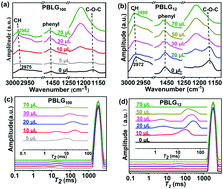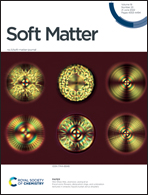The effect of hydration and dehydration on the conformation, assembling behavior and photoluminescence of PBLG†
Abstract
Hydration and dehydration play crucial roles in hydrophobic effects (HEs) and are yet to be understood. Poly(γ-benzyl-L-glutamate) (PBLG) homopolymers in THF/water with various water contents were investigated. We discovered that PBLG was hydrated at low water contents and adopted a helical conformation. The chain became dehydrated with increasing water content, which converted the PBLG100 helix to a PPII-helix. The variation in the conformation resulted in an alteration of the self-assembled morphologies from fibers to particles. For PBLG12 with a shorter chain, the chain underwent an α-to-β transition in the conformation due to dehydration as the water content increased, and correspondingly the morphologies varied from tapes to helical ribbons, and eventually to toroids at a higher water content. We also observed that this α-to-β transition is accompanied by an increase in intensity of the fluorescence, which is attributed to the through-space-conjugation of tightly packed phenyl groups within the β-sheet. The discovered effect of hydration and dehydration on the PBLG chain conformation, self-assembling behavior and optical function is essential for the innovation of polypeptide materials and understanding of water-mediated biological systems.



 Please wait while we load your content...
Please wait while we load your content...